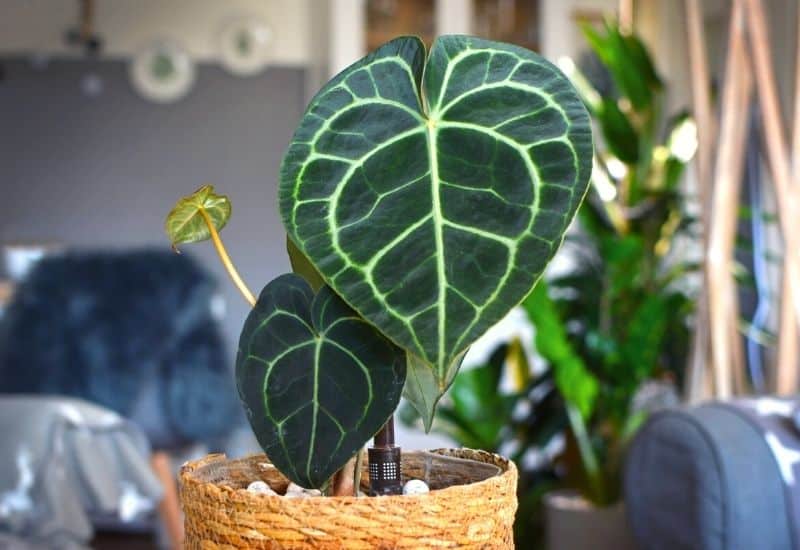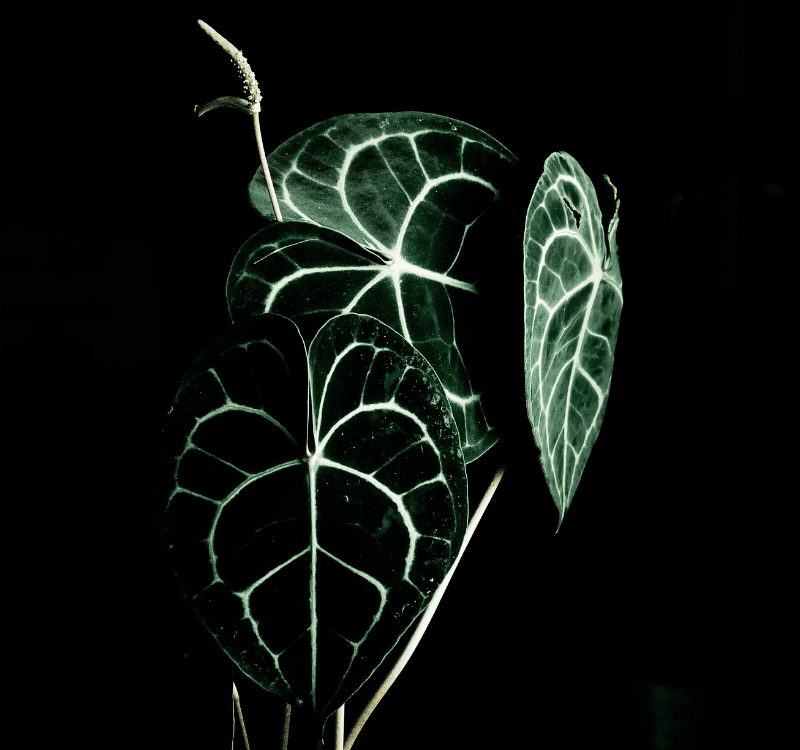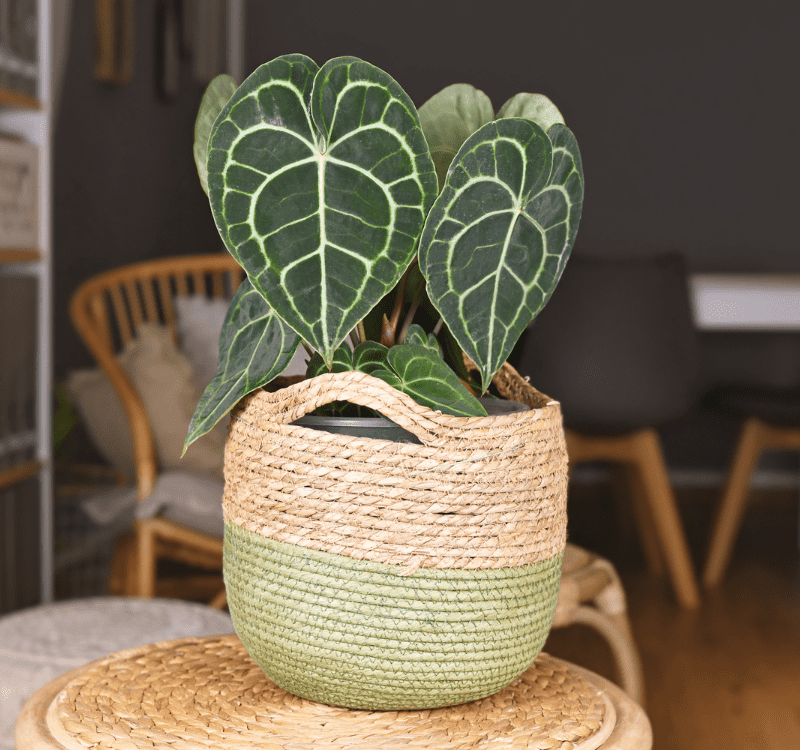The anthurium clarinervium plant is a low-maintenance plant that gives any room it’s in a very exotic look. The most eye-catching feature is its broad heart-shaped leaves, which are a beautiful shade of dark green and feel velvety to the touch. It also produces gorgeous solid-colored blossoms in a variety of bright colors, adding to the beauty and uniqueness of the plant.
Anthurium Clarinervium Care Guide Overview
- How To Plant (when & where)
- How To Grow (staking, watering, fertilizing, humidity, mulching)
- How To Trim And Prune
- How To Pot And Repot
- How To Propagate (when & how)
- And Pests and Diseases, Plant Species, Companions, Toxicity
Characteristics
- Scientific name/common names: Anthurium clarinervium; part of the Araceae family/velvet cardboard anthurium
- Origin: Chiapas, Mexico
- Indoor/outdoor: does better indoors
- Height/structure: up to 25 inches high and up to 40 inches wide; has a very strong stem that keeps it nice and erect
- Temperature: between 54 and 74 degrees Fahrenheit
- Flower color: red, pink, white, and green
How to Plant and Grow the Anthurium Clarinervium

The first thing to remember about the anthurium clarinervium plant is that even though it is a low-maintenance plant, it still requires some special care at certain times. For one thing, direct sunlight can damage the plant, so while it does need a lot of light, make sure it’s indirect light.
The reason for this is that an anthurium clarinervium plant is very sensitive to heat, and too much heat can scorch and burn the leaves of the plant. Keeping the plant in temperatures of 55 to 80 degrees Fahrenheit is a must.
In fact, the anthurium clarinervium is very sensitive to temperatures that are either too high or too low. For best results, you should always keep this plant away from strong winds, air conditioners, heaters, and so on, because it needs to be away from extreme temperatures at all times.
These things are especially important during the summer months, so making sure it isn’t placed on a window sill that is constantly exposed to the hot sun is crucial. It needs heat and light, but both should be indirect and not direct.
This being said, you still want to keep this plant in a well-ventilated area because good air circulation helps it grow and thrive. Just don’t put it right next to a fan or something else that is blowing directly on it.
Keep in mind that in addition to the right temperature, this is one plant that loves moisture and humidity. In fact, the closer you can get the humidity level to 80%, the better the plant will do. This is why a lot of people keep their anthurium clarinervium plant in their bathroom or in a room with a humidifier in it. The minimum humidity level for this plant should be at 50%.
Watering and Soil

As far as the soil is concerned, you have to be careful because since the anthurium clarinervium loves humidity and moisture, the roots of the plant can become damaged by water. The best thing to do is to mix up compost soil and peat, preferably with a pH level of 6.5, so that healthy growth is a lot easier.
Keep in mind that with the soil, you’ll want to use a combination of water-holding soil and soil made out of fibrous materials. A few ideas include potting soil and orchid mix soil in equal ratios; potting soil and perlite; or potting soil mixed with perlite, charcoal, moss, gravel, and mulch.
The main thing to remember when watering your anthurium clarinervium is to check the top part of the soil with your finger first. Only when it feels dry to the touch will it need a good watering. You will not need to water this plant every day!
Humidity
When you do water it, add enough water so that the excess water comes out of the bottom of the pot, then stop watering. It’s also a good idea to use a mist sprayer on the leaves to keep it nice and humid. This is especially important if you live in a dry climate.
Misting also keeps the plant shiny and avoids damages during the summer months. Using a mist sprayer on this plant isn’t necessary, but it helps keep the plant as humid and moist as it prefers to be.
If you want to make sure your anthurium clarinervium plant has enough humidity throughout the year, place a tray filled with pebbles and water at the bottom of the pot. This keeps the moisture and humidity level even the entire time.
Trimming and Pruning
If you prune your anthurium clarinervium plant, it not only improves the appearance of the plant but also helps it grow better. Remember that these plants have thick leaves and very strong stems, so it takes a lot to actually damage them.
Nevertheless, regular pruning and trimming is a good idea, and you should start by removing all of the discolored leaves first. If the leaves are simply too long or they are brown in color, they should be cut off with a pair of scissors or some pruning shears. If you see any blossoms on the plant that are no longer healthy, go ahead and cut them off as well.
Naturally, if there are spots on the leaves, they need to be cut off with scissors or shears because this is usually a sign of some type of disease that might possibly spread to other parts of the plant.
Pot And Repotting

Every two to three years, you should also repot your anthurium clarinervium plant. Repotting gives the plant enough room to continue to grow right, and it will let you know when it’s time to repot. Check your anthurium clarinervium regularly to make sure it has enough room to continue to grow.
If you see the roots growing out of the bottom of the pot, or even worse, growing in your soil, it is definitely time to repot the plant. Remember that the anthurium clarinervium plant has large leaves and a very strong stem, so it will need enough room to continue to support these things.
The main thing you want to keep in mind when buying a new pot is to find one that is only a few inches bigger than the previous pot. You won’t want to buy a pot that is twice the size as the one you have now. Just buy one that’s slightly bigger for the best results.
Another important tip when repotting is to use the exact same type of soil as you did previously. Do not try something different just because you are repotting your anthurium clarinervium plant. To make it easier to remove the plant out of the old pot, wet the plant first so the soil will stick together and the root system won’t fall apart.
Finally, since the new leaves and stems of the anthurium clarinervium plant always sprout from the top, you may want to consider some type of support for your plant. This includes a stake, pole, or even the stem of an old plant. This support helps the plant keep its attractiveness and stay erect so it can grow properly.
Pests and Diseases
Anthurium clarinervium plants, like many other indoor plants, attract many different types of sucking pests that feed on the sap of plants. Pests like to hide in the broad leaves of the anthurium clarinervium plant, so it’s sometimes difficult to see them.
Regular inspection of the plant, therefore, is crucial because it means you can catch these pests before they become too difficult to get rid of. If you do find pests, here are some things you can do to remove them from the plant:
- Clean the plant and leaves with a good horticultural soap.
- Use an oil spray all over the plant, which will repel the pests and keep them away.
- Spray an insecticide that contains pyrethrin all over the plant.
Some people even use mild soap and water to wash the pests off of the plant. As you can see, you have a lot of options for getting rid of the pests you may find on your anthurium clarinervium plant. The important thing to do when you see pests is (1) get rid of the pests as soon as possible, and (2) take the necessary steps – i.e., use the necessary products – to make sure the pests don’t come back.
One of the things people love the best about this plant is its flowers. Called flamingo flowers, they look similar to the plant’s leaves but come in bright colors such as pink, red, white, and even green. They don’t look like regular flowers with petals but are similar to the leaves of the plant in shape and size.
These blossoms have a velvety, shiny texture and are around three to four inches in size. Once they appear on your anthurium clarinervium plant, they’ll last several weeks and then fade and drop to the ground. Some people consider them not very attractive, but each person is different.
If you want to add an exotic touch to a floral bouquet, you can use the flowers of the anthurium clarinervium plant. If they wither and start to fade, however, it’s best to go ahead and prune them with shears or scissors so the plant itself remains looking good.
Propagation
Regarding propagation of the anthurium clarinervium plant, it can be done in one of three ways, which includes:
- Seeds: This is a time-consuming venture because you’ll have to wait a whole year before anything happens. Once pollination occurs, berries will form and then drop off of the plant. When this happens, open the berries to get the seed out and then plant the seeds. You’ll have to use potting mix that is finer than the mix used if you propagate from stem cuttings or the division method. Still, houseplant enthusiasts who love to plant things from scratch will appreciate the process.
- Stem cuttings: Start with a four- to six-inch cutting from the tip of new growth, and choose one that already has aerial roots. For better results, dust the cut with some type of fungicide or even cinnamon so it doesn’t get an infection. Plant the cuttings in the same type of potting mix as you would a growing plant. If you like, you can take an older stem, cut it into sections, and bury each section horizontally in case the first one doesn’t work. If you do this, make sure each section has some roots and at least one leaf on it.
- Division: This is usually the most effective method of propagating your anthurium clarinervium plant. Unpot the plant very gently and look for smaller stem sets, making sure they each have at least one leaf and their roots. You should be able to get several divisions from each of your plants, which you can then plant using the same potting mix as you did in the original plant. Make sure you water it well at that point so that the roots can start to grow quickly.
Propagating the anthurium clarinervium plant isn’t that difficult, but it does take a little patience and occasionally some extra TLC. If you want to be successful at it, make sure you follow all of these instructions to the letter and if you need to, speak with a nursery representative to make sure you’re doing all you can to be a success.
Plant Species & Companions
If you’ve fallen in love with the anthurium clarinervium plant and want some nice companions to this type of houseplant, here are some others in the same family you may want to check out:
- Anthurium andreanum: bright-red flowers and shiny heart-shaped foliage make this one exquisite plant.
- Anthurium scherzerianum: this one has curly flowers that look like pigs’ tails.
- Anthurium watermaliense: also called the black anthurium, this one has flowers that are a beautiful shade of deep purple.
- Anthurium hookeri: this one is also called the bird’s nest and has leaves that are dark green in color and an elongated shape.
Toxicity
Since the anthurium clarinervium plant contains calcium oxalate crystals, it is a very toxic plant. In fact, every part of the plant is toxic and, therefore, it should never be allowed near any small children or pets. Severe health problems can arise if the plant is ingested, including ulcers in the throat and esophagus.
For these reasons, never let small children or pets anywhere near your anthurium clarinervium plants. They should not even be allowed to touch these toxic houseplants.


